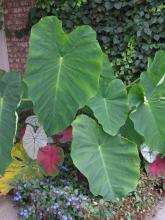
High Plains Gardening
The gardening website of the Texas High Plains Region

Elephand ears are plants grown from corms (called bulbs, but not true bulbs), with large leaves on upright stems. Colocasia leaves point downward (Alocasia leaves point upward). Colocasia gigantum and C. esculenta are two species most often used. These plants are grown primarily for their foliage and prominant veining, rather than flowers. The flowers are typical aroid type with a white to yellow or light green spathe, and may not even flower in shorter growing seasons.
'Black Magic', 'Hilo Beauty', 'Lime Zinger' and 'Mojito' are a few of the many cultivars of C. esculenta. New cultivars come out each year. Caladiums and Xanthosomas are similar in appearance often also referred to as elephant ears. Caladiums have smaller leaves and shorter petioles. Xanthosomas are quite similar to Colocasias, but are native to tropical areas of Central and South America.
For additional information on elephant ear species and cultivars, click here.
Shady, high water-use area in nutrient rich soil. They make great container plants and will grow right in ponds. Cultivars with dark leaves can be planted in the sun, and should be kept moist.
Plant a number of corms of differing species and or cultivars for a touch of tropicalisimo.
Plant elephant ear tubers around Mother's Day. If planted when it is cool or cold, the tubers will rot. Dig up tubers in the fall after foliage has died back from frost. Air dry out of the sun for a week or two, then store inside in uncovered plastic bin. Add compost each year for best results.